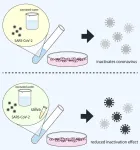(Press-News.org) Tiny copper ‘nano-flowers’ have been attached to an artificial leaf to produce clean fuels and chemicals that are the backbone of modern energy and manufacturing.
The researchers, from the University of Cambridge and the University of California, Berkeley, developed a practical way to make hydrocarbons – molecules made of carbon and hydrogen – powered solely by the sun.
The device they developed combines a light absorbing ‘leaf’ made from a high-efficiency solar cell material called perovskite, with a copper nanoflower catalyst, to convert carbon dioxide into useful molecules. Unlike most metal catalysts, which can only convert CO₂ into single-carbon molecules, the copper flowers enable the formation of more complex hydrocarbons with two carbon atoms, such as ethane and ethylene — key building blocks for liquid fuels, chemicals and plastics.
Almost all hydrocarbons currently stem from fossil fuels, but the method developed by the Cambridge-Berkeley team results in clean chemicals and fuels made from CO2, water and glycerol – a common organic compound – without any additional carbon emissions. The results are reported in the journal Nature Catalysis.
The study builds on the team’s earlier work on artificial leaves, which take their inspiration from photosynthesis: the process by which plants convert sunlight into food. “We wanted to go beyond basic carbon dioxide reduction and produce more complex hydrocarbons, but that requires significantly more energy,” said Dr Virgil Andrei from Cambridge’s Yusuf Hamied Department of Chemistry, the study’s lead author.
Andrei, a Research Fellow of St John’s College, Cambridge, carried out the work as part of the Winton Cambridge-Kavli ENSI Exchange programme in the lab of Professor Peidong Yang at University of California, Berkeley.
By coupling a perovskite light absorber with the copper nanoflower catalyst, the team was able to produce more complex hydrocarbons. To further improve efficiency and overcome the energy limits of splitting water, the team added silicon nanowire electrodes that can oxidise glycerol instead. This new platform produces hydrocarbons much more effectively — 200 times better than earlier systems for splitting water and carbon dioxide.
The reaction not only boosts CO₂ reduction performance but also produces high-value chemicals such as glycerate, lactate, and formate, which have applications in pharmaceuticals, cosmetics, and chemical synthesis.
“Glycerol is typically considered waste, but here it plays a crucial role in improving the reaction rate,” said Andrei. “This demonstrates we can apply our platform to a wide range of chemical processes beyond just waste conversion. By carefully designing the catalyst’s surface area, we can influence what products we generate, making the process more selective.”
While current CO₂-to-hydrocarbon selectivity remains around 10%, the researchers are optimistic about improving catalyst design to increase efficiency. The team envisions applying their platform to even more complex organic reactions, opening doors for innovation in sustainable chemical production. With continued improvements, this research could accelerate the transition to a circular, carbon-neutral economy.
“This project is an excellent example of how global research partnerships can lead to impactful scientific advancements,” said Andrei. “By combining expertise from Cambridge and Berkeley, we’ve developed a system that may reshape the way we produce fuels and valuable chemicals sustainably.”
The research was supported in part by the Winton Programme for the Physics of Sustainability, St John’s College, the US Department of Energy, the European Research Council, and UK Research and Innovation (UKRI).
END
Tiny copper ‘flowers’ bloom on artificial leaves for clean fuel production
2025-02-03
ELSE PRESS RELEASES FROM THIS DATE:
Cracks in Greenland Ice Sheet grow more rapidly in response to climate change
2025-02-03
Embargoed until 10am GMT UK time (5am US Eastern Time) on Monday 03 February 2025 (Nature Geoscience embargo)
-With pictures-
The Greenland Ice Sheet is cracking open more rapidly as it responds to climate change.
The warning comes in a new large-scale study of crevasses on the world’s second largest body of ice.
Using 3-D surface maps, scientists led by Durham University, UK, found crevasses had significantly increased in size and depth at the fast-flowing edges of the ice sheet over the ...
Computer model helps identify cancer-fighting immune cells key to immunotherapy
2025-02-03
*EMBARGOED FOR RELEASE UNTIL MONDAY, FEB. 3, AT 5 A.M. ET*
Researchers at the Johns Hopkins Kimmel Cancer Center and Bloomberg~Kimmel Institute for Cancer Immunotherapy have developed a computer model to help scientists identify tumor-fighting immune cells in patients with lung cancer treated with immune checkpoint inhibitors.
In their study published Feb. 3 in Nature Communications, the team, including first author Zhen Zeng, Ph.D., a bioinformatics research associate at the Kimmel Cancer Center, demonstrated that their three-gene “MANAscore” computer model can identify ...
Keeper or corner?
2025-02-03
Our brain is remarkably flexible in producing different reactions to supposedly comparable situations. The same sensory information can lead to different decisions depending on the behavioral context. One example of this is a penalty kick in soccer: a player can either choose the empty corner of the goal as the target or aim directly at the goalkeeper in the hope that he will jump aside. Both decisions are based on the same perception of the goalkeeper's position, but lead to completely different actions. Neuroscientists at the German Primate Center (DPZ) - Leibniz Institute for Primate Research in Göttingen have investigated how the brain implements this ...
Printable molecule-selective nanoparticles enable mass production of wearable biosensors
2025-02-03
The future of medicine may very well lie in the personalization of health care—knowing exactly what an individual needs and then delivering just the right mix of nutrients, metabolites, and medications, if necessary, to stabilize and improve their condition. To make this possible, physicians first need a way to continuously measure and monitor certain biomarkers of health.
To that end, a team of Caltech engineers has developed a technique for inkjet printing arrays of special nanoparticles that enables the mass production of long-lasting wearable sweat sensors. These sensors could be used to monitor a variety of biomarkers, ...
Mapping the yerba mate genome reveals surprising facts about the evolution of caffeine
2025-02-03
Yerba mate, along with tea and coffee, is one of the world’s most popular caffeinated beverages. Widely consumed in South America, this remarkable plant is rich in diverse, bioactive compounds that contribute many health benefits.
An international group of researchers has mapped the yerba mate genome, providing insights into the biosynthesis of caffeine in yerba mate. This new information provides opportunities for creating plant varieties with new characteristics.
The work, led by the ...
Electricity prices across Europe to stabilise if 2030 targets for renewable energy are met, study suggests
2025-02-03
Hitting the current national 2030 quotas for solar and wind energy could reduce the volatility of electricity markets by an average of 20% across 29 European countries, according to a new study from the University of Cambridge.
The intensity of spikes in power prices are predicted to fall in every country by the end of the decade if commitments to green energy are met, as natural gas dependency is cut.
The UK and Ireland would be the biggest beneficiaries, with 44% and 43% reductions in the severity of electricity price spikes by 2030, compared with last year.
Germany could experience a 31% decline in electricity price ...
Improved treatment timing reduces honey bee losses to Varroa mites
2025-02-03
Honey bee mortality can be significantly reduced by ensuring that treatments for the parasitic Varroa mite occur within specific timeframes, a new study reveals.
The mites—belonging to the species Varroa destructor—feed on the larvae of bees and can destroy colonies if not treated at key points to reduce or remove infestations.
But researchers have found that more than a third of beekeepers surveyed in England and Wales deviate from recommended treatment guidelines, including application windows.
Crucially, they found that beekeepers who mistimed Varroa mite treatments experienced exacerbated colony losses, with the effect occurring ...
CAR-T cells can arm bystander T cells with CAR molecules via trogocytosis
2025-02-03
Engineered immune cells called CAR-T cells are used in the treatment of cancer. Researchers from Uppsala University have now discovered that CAR molecules can be transferred from the CAR-T cells to other T cells in the tumour microenvironment. The researchers also pinpoint how this transfer is regulated, which may be used to improve the efficacy of CAR-T cell therapy. The study has been published in the journal Science Immunology.
Immune cells have a capacity to exchange cell surface molecules between one another. This exchange is called trogocytosis and may potentially impact the immune response since it allows different proteins to be transferred between cells.
Chimeric antigen ...
Can ocean-floor mining oversights help us regulate space debris and mining on the Moon?
2025-02-03
by Nishith Mishra, Martina Elia Vitoloni, and Dr Joseph Pelton
Mining ocean resources needed for electric cars and other devices is currently a hot issue of dispute. Final resolution of how or whether the seabed should be expl18oited is pending. Outcomes in this contentious area could create precedents that could impact decisions about mining the moon.
These precedents might shape the how and why of mining the Moon and shape the future and the sustainability of space activities of human beings. But this is only one possible precedent that could reshape the future of space.
Pending international discussions on space traffic management, space debris removal, and limiting ...
Observing ozonated water’s effectiveness against SARS-CoV-2 in saliva
2025-02-03
Disinfecting surfaces is crucial in keeping bacteria and viruses at bay, but the cleaning solutions could be ineffective if met with neutralizing compounds.
Ozonated water has a strong disinfection effect on mold and bacteria, and is also shown to work on SARS-CoV-2, which is responsible for COVID-19. The downside is that ozonated water breaks down quickly in the presence of organic matter, which reduces its effectiveness. SARS-CoV-2 is transmitted through droplets mixed with bodily fluids, such as saliva and nasal mucus which contain organic matters. For this reason, it is necessary to investigate how effective ozonated water is in the presence of ...








